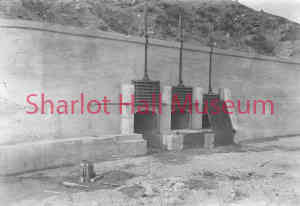Roosevelt Dam, Beginning Construction
details
Unknown Unknown 1025.0120.0016.jpg DAM-120 B&W 1025-0120-0016 1025.0120.0016 Print 4x6 Historic Photographs c. 1905 - 1911 Reproduction requires permission. Digital images property of SHM Library & ArchivesDescription
Theodore Roosevelt Dam, the first major structure constructed by the Bureau of Reclamation on the Salt River Project, is located about 76 miles northeast of Phoenix and 30 miles northwest of Globe, Arizona. The dam, completed in 1911, was subsequently modified between 1989 and 1996. The original dam was a cyclopean, rubble-masonry, thick-arch structure that spanned the Salt River to form a reservoir of 1,381,580 acre-feet. It was 280 feet high, 723 feet long at the crest, and contained 355,800 cubic yards of masonry.
Back of photograph reads: "Gates at intake of power canal."
Purchase
To purchase this image please click on the NOTIFY US button and we will contact you with details
The process for online purchase of usage rights to this digital image is under development. To order this image, CLICK HERE to send an email request for details. Refer to the ‘Usage Terms & Conditions’ page for specific information. A signed “Permission for Use” contract must be completed and returned. Written permission from Sharlot Hall Museum is required to publish, display, or reproduce in any form whatsoever, including all types of electronic media including, but not limited to online sources, websites, Facebook Twitter, or eBooks. Digital files of images, text, sound or audio/visual recordings, or moving images remain the property of Sharlot Hall Museum, and may not be copied, modified, redistributed, resold nor deposited with another institution. Sharlot Hall Museum reserves the right to refuse reproduction of any of its materials, and to impose such conditions as it may deem appropriate. For certain scenarios, the price for personal usage of the digital content is minimal; CLICK HERE to download the specific form for personal usage. For additional information, contact the Museum Library & Archives at 928-445-3122 ext. 14 or email: orderdesk@sharlot.org.




